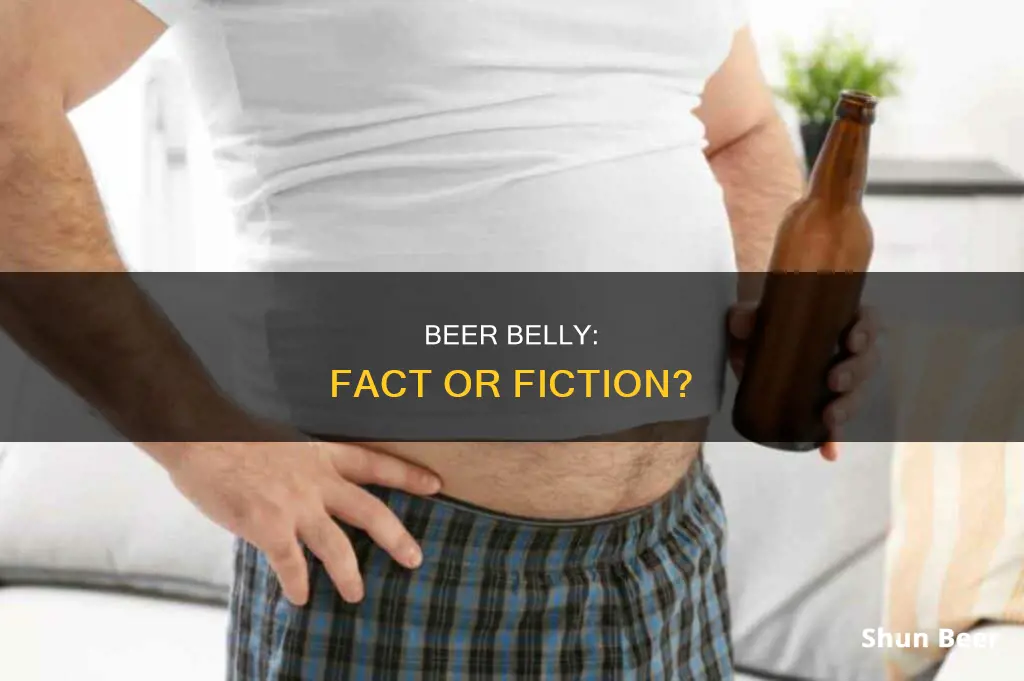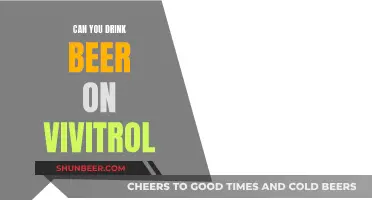
Whether it's called a beer belly, a spare tire, the apple shape, or the middle-age spread, abdominal obesity is a health hazard. Drinking beer is often associated with an increase in body fat, particularly around the belly. But is it really beer that causes a beer belly? Beer contains as many calories as a soft drink, so it has the potential to add a lot of calories to your diet. Beer also stimulates your appetite, which can lead you to eat more than you otherwise would. Alcohol also gets in the way of your body's ability to burn fat. However, research from the Czech Republic found that in a study of nearly 2,000 adults, beer consumption was not related to girth.
| Characteristics | Values |
|---|---|
| Calories | A typical beer has 150 calories |
| Appetite | Alcohol increases appetite |
| Fat burning | Alcohol prevents the body from burning fat |
| Phytoestrogen | Beer contains phytoestrogen, which can cause hormonal changes |
| Health risks | Linked to type 2 diabetes, high blood pressure, cardiovascular disease, erectile dysfunction, fatty liver disease, polycystic ovary syndrome |
What You'll Learn

Beer contains a lot of calories
The more alcohol a beer contains, the more calories it has. Alcohol has about seven calories per gram, higher than carbs and protein (four calories per gram) but lower than fat (nine calories per gram). Beer is high in carbs and alcohol but low in almost all other nutrients.
Drinking beer can also increase your appetite and impair your judgment, leading to less healthy food choices. Alcohol stimulates your appetite, so you may eat more than you would otherwise. And when you're drinking beer, the food on hand is often fattening fare like pizza, wings, and other fried foods.
Beer also interferes with fat burning. Your liver plays an important role in metabolizing proteins, carbohydrates, and fats, but when you consume alcohol, your liver burns alcohol instead of fat. So, drinking beer can hinder your body's ability to burn off fat.
Drinking Beer on NY Streets: What's the Law?
You may want to see also

Alcohol prevents fat burning
Alcohol also increases your calorie intake. Gram for gram, beer contains as many calories as a soft drink, and it's easy to consume multiple beers in one sitting, leading to a serious calorie overload. Alcohol can also increase your appetite and cravings for fatty foods, causing you to eat more than you otherwise would.
Additionally, alcohol affects your organs, particularly the liver, which plays a crucial role in metabolising fats, carbohydrates, and proteins. Excess alcohol consumption can lead to alcoholic fatty liver, which can damage your liver and affect how your body metabolises and stores carbohydrates and fats. This change in energy storage can make it very difficult to lose weight.
While drinking in moderation may not significantly increase cravings, it can still interfere with your body's metabolic pathways. The less you drink, the easier it is for your body to get back into fat-burning mode.
Drinking Non-Alcoholic Beer in Public: Is It Okay?
You may want to see also

Beer stimulates your appetite
Beer also contains a lot of calories. A typical beer has 150 calories, and if you drink several in one sitting, you can end up with a serious calorie overload. A calorie overload can lead to an increase in body fat, and because men tend to store more fat in their bellies, this can result in a "beer belly".
Beer also prevents your body from burning fat. When you consume alcohol, your liver burns alcohol instead of fat. This means that regular drinking could contribute to an increase in body fat.
It's not just the beer causing the "beer belly", but it can certainly contribute to abdominal obesity by adding extra calories.
Bottoms Up Beer Dispensers: How Do They Work?
You may want to see also

Beer contains phytoestrogens
The link between beer and "beer bellies" has been attributed to the presence of phytoestrogens, which are plant compounds that can mimic the female sex hormone, oestrogen. This can cause hormonal changes in men, increasing the risk of storing belly fat. However, the extent to which phytoestrogens contribute to weight gain is not fully understood. While it is possible that men who drink beer are exposed to higher levels of phytoestrogens, the impact of these plant compounds on weight and belly fat is unclear.
The original theory behind the development of "man boobs" and other feminine traits in alcoholic men was that alcohol-induced liver damage led to the retention of excess oestrogens in the body. However, when researchers measured oestrogen levels, they found no elevation. This led to the consideration of alternative explanations, including the possibility of exposure to exogenous estrogenic substances from dietary sources, such as phytoestrogens in the plants used to make alcoholic beverages.
In 1999, researchers identified 8-prenylnaringenin, a potent phytoestrogen in hops and beer. This discovery provided an explanation for the menstrual disturbances experienced by female hop workers in the past. While the levels of 8-prenylnaringenin in beer are considered too low to affect human health, it is important to note that the intestinal microbial community can increase the exposure concentration through biotransformation. This results in the detection of 8-prenylnaringenin in the urine of beer drinkers for days after consumption.
While beer contains phytoestrogens, it is important to consider other factors that contribute to weight gain and the development of a "beer belly". Beer is high in calories, with a typical beer containing about 150 calories. Alcohol can also increase appetite and is often consumed with fatty foods, leading to excess calorie consumption. Additionally, drinking alcohol can prevent the body from burning fat, as the body prioritises the breakdown of alcohol over other sources of fuel, including stored fat.
Monks and Beer: A Spiritual Perspective on Drinking
You may want to see also

Beer is linked to serious health problems
While the term "beer belly" is commonly used to refer to excess abdominal fat, beer is not solely responsible for this physical trait. Instead, it is caused by consuming more calories than are burned through exercise. However, beer can contribute to abdominal obesity by adding extra calories. A typical beer contains approximately 150 calories, and these calories can quickly add up if you drink several in one sitting.
Excess abdominal fat is linked to various health problems, and a large "beer belly" can indicate a high accumulation of visceral fat, which is particularly harmful. Visceral fat is located in and around the organs inside the abdomen, and it can increase the risk of serious health issues. Here are some of the ways in which beer is linked to serious health problems:
- Interference with fat burning: Alcohol disrupts the body's ability to burn fat. Usually, the liver metabolises proteins, carbohydrates, and fats, but when alcohol is present, the liver prioritises burning it over other sources of fuel, including stored fat. This can lead to an increase in body fat over time.
- Increased calorie intake: Beer contains a significant number of calories. Gram for gram, it has as many calories as a soft drink. Drinking beer can also increase your appetite and impair your judgment, leading to unhealthy food choices and excess calorie consumption.
- Hormonal impact: The hops used to flavour beer contain high levels of phytoestrogens, plant compounds that can mimic the female sex hormone oestrogen. This can potentially lead to hormonal changes in men, increasing their risk of storing belly fat.
- Health risks associated with visceral fat: Having a large amount of visceral fat, as indicated by a protruding "beer belly," increases the risk of health problems such as heart disease, metabolic syndrome, type 2 diabetes, high blood pressure, cardiovascular disease, erectile dysfunction, fatty liver disease, and cancer.
- Impact on other organs: Excessive alcohol consumption affects not only the liver but also the brain and heart. It can also increase the risk of certain types of cancer.
Mixing Milk and Beer: A Safe Drinking Combination?
You may want to see also
Frequently asked questions
Drinking beer can cause weight gain, including belly fat, but it is not the only cause of a "beer belly." Excess calories, whether from alcohol, sugary drinks, or large portions of food, can increase belly fat. Alcohol also stimulates your appetite, which can lead to increased food consumption.
A "beer belly" is a term used to describe abdominal obesity, which is a health hazard that increases the risk of heart attack, stroke, diabetes, and other issues.
To get rid of a beer belly, it is recommended to reduce alcohol intake, exercise regularly, and improve your diet. Lower-calorie or non-alcoholic beers can also help.







